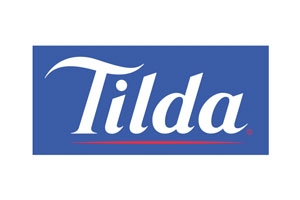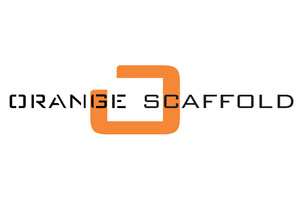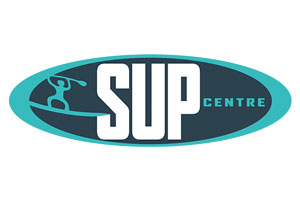All about SUP paddles
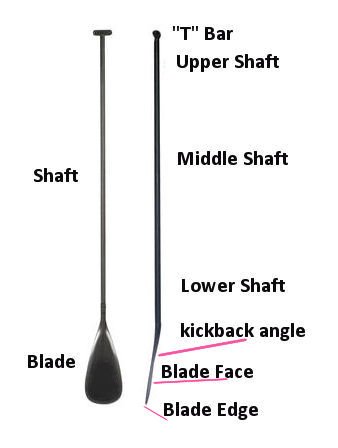
SUP paddles are single-bladed, with a (generally) T-shaped handle at the top. There are a bewilderingly large array of styles, construction variations and price points available, so choosing a paddle can be quite a daunting task. Nevertheless, it’s important to get it right, as your paddle is your motor. If it’s not matching your requirements, it can reduce both your paddling enjoyment and efficiency.
Here are a few of the main parameters and variations that you need to consider:
Anatomy of a stand-up paddle
The diagram shows the names of the various parts of the paddle. One important feature of a SUP paddle is the rake, or kickback angle between the shaft and the blade. The diagram refers to the handle at the top as a ‘T-bar’, it’s often also called a T-piece, or simply ‘the handle’!
Weight and stiffness
As you are wielding this paddle pretty much non-stop while on the water, there is a lot to be said for having a lighter paddle. However, weight saving is usually achieved by either making it of thinner construction, so it’s less strong, or using lighter materials such as carbon in the construction, which generally means a higher price tag, and often more fragility. So it’s up to your relationship with your bank manager as to how expensive a paddle you choose to go for.
Stiffness also plays a major factor in determining how a paddle feels and performs. A stiffer paddle ensures that more of the energy you apply to the stroke is converted into forward propulsion, rather than just bending the paddle. (It is also a factor once you get good at wave riding and start using the paddle to turn). However, too stiff a paddle for your weight can feel lifeless and unresponsive, so it’s not just a case of going for the stiffest paddle possible – especially as stiffer usually means more carbon, and thus more expense.
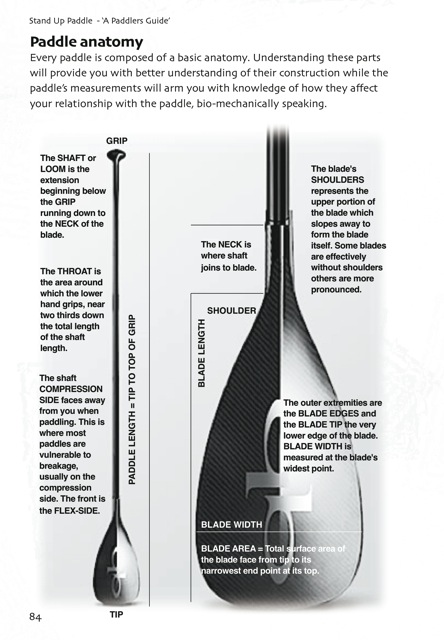 This page is taken from Steve West’s book “Stand Up Paddle – A Paddlers Guide”, and gives a more comprehensive breakdown of the various parts, and terms you will hear used.
This page is taken from Steve West’s book “Stand Up Paddle – A Paddlers Guide”, and gives a more comprehensive breakdown of the various parts, and terms you will hear used.
Construction
At the bottom end of the price scale are simple aluminium-shafted paddles with plastic blades. Aluminium isn’t a great material for SUP paddles – it’s cold to the touch, heavy and the paddles are generally very unresponsive. They are cheap, but if you’re planning on doing more than very occasional short outings on your SUP board, it’s well worth spending a few more dollars to get something with more performance. Note also that adjustable aluminium paddles tend to sieze up very quickly if used in salt-water conditions. Unless you rinse them out with fresh water pretty much after every single use, they will soon become non-adjustable!
Fiberglass is a robust material, with good flex characteristics, and a reasonable price point. The majority of paddles sold are fiberglass, or a composite of fiberglass and carbon. And then, as the performance and price point rise, we get into the realms of carbon. However, it’s important to understand that a carbon paddle is not simply the best option by default. There is a lot more to the construction of a paddle than simply what it’s made of, and there are plenty of cheap carbon paddles which actually aren’t that great. You get what you pay for.
The other material occasionally used in paddle construction is wood, and a well-made wood paddle is indeed a pleasure to use. However, these tend to be made by enthusiasts and are more of a ‘custom item’, and not cheap either, as it’s a time-consuming process requiring a lot of skill and technique.
Adjustable vs fixed length
Paddles are either fixed in length, cut to size for the individual rider (see below) and the handle glued into position, or they have an adjustment system so their length can be changed. Fixed length paddles inevitably offer the best performance, as they have uniform bend characteristics and are lighter than adjustables, but adjustable-length paddles still make a whole lot of sense for many users. If more than one person is going to be using a board, it’s obviously important to have a paddle that can cater for different heights of rider. But even if you’re the only person using it, you may well find, unless you’re already extremely experienced, that your paddle technique evolves and improves, and you find a longer (or shorter!) paddle suits you better. An adjustable paddle allows you to experiment with different lengths and see what works for you. Also, many riders change paddle length for different conditions, using a much longer paddle for distance or racing than they do in the surf, where a shorter paddle can dramatically aid manoeuvrability.
A good plan is to start out with an adjustable paddle, of a middling price point and material (ie fiberglass), and then, once you feel you know exactly what height you like your paddle at, you can invest in a higher performance blade. The adjustable paddle will still be a handy fallback for when you are lending your board to friends and family.
How long should your paddle be?
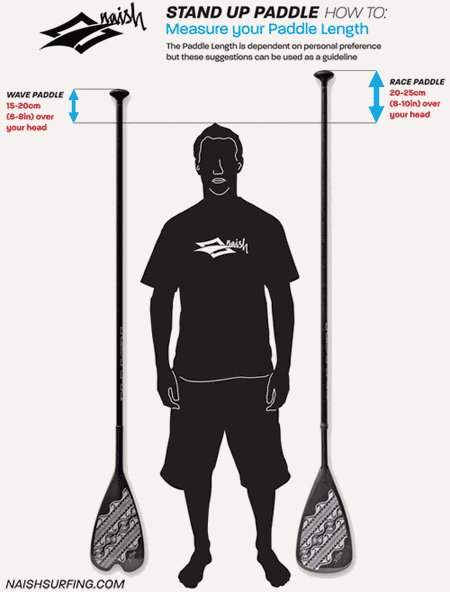 There are a hundred different answers to this on the internet, and -typically – most are wrong. The truth is, there is no simple formula or rule that can tell you how long to have your paddle. It is determined by your paddling style, and as mentioned above, it also varies according to what you’re going out to do on your board, and other factors such as the thickness of your board, and simply your mood or fitness, can change the ideal length for you. A good ballpark ‘start from here’ measurement is simply the ‘shaka over the head’ method, ie stand upright and straight, with your paddle blade is touching the floor in front of your feet, put your thumb on the top of your head, stick your little finger up as high as it will go, and that’s about where the top of the handle should be. You may find you need to adjust several inches either side of that, but at least it’s going to be in the right ballpark.
There are a hundred different answers to this on the internet, and -typically – most are wrong. The truth is, there is no simple formula or rule that can tell you how long to have your paddle. It is determined by your paddling style, and as mentioned above, it also varies according to what you’re going out to do on your board, and other factors such as the thickness of your board, and simply your mood or fitness, can change the ideal length for you. A good ballpark ‘start from here’ measurement is simply the ‘shaka over the head’ method, ie stand upright and straight, with your paddle blade is touching the floor in front of your feet, put your thumb on the top of your head, stick your little finger up as high as it will go, and that’s about where the top of the handle should be. You may find you need to adjust several inches either side of that, but at least it’s going to be in the right ballpark.
This diagram comes from the Naish website, and isn’t a bad approach, either.
Blade size and style
Blades come in a wide variety of shapes and sizes. A narrower blade is known as a high-aspect or high-cadence blade, and is better suited to those who like to paddle at a high stroke rate, or don’t have a lot of power (because they are light, short, not particularly strong in the arm or a combination of all three). Conversely, tall powerful riders often prefer a wider, lower-aspect blade. Blades with smaller surface area (not necessarily high-aspect, but simply smaller in both length and width) are popular for SUP surfing.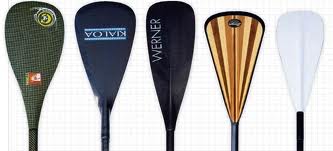 Most blades are now of the ‘teardrop’ shape, a relatively narrow neck ballooning out into a wider base. If you’re not sure what you want, then a blade of this style makes a good starting point, as it’s time-proven, and generally pretty comfortable to use.
Most blades are now of the ‘teardrop’ shape, a relatively narrow neck ballooning out into a wider base. If you’re not sure what you want, then a blade of this style makes a good starting point, as it’s time-proven, and generally pretty comfortable to use.
The other variant in blade style is whether the blade has dihedral – ie a sort of ridge down the middle, as opposed to a completely flat surface. Flat-faced blades generally require a more aggressive paddling style otherwise they tend to ‘flutter’.
The best advice with paddles is simply to try as many as possible, see what works for you, and what you like the feel of! And if you do have an adjustable paddle, don’t be afraid to experiment. Don’t assume that just because it feels about right, it’s not going to feel even better an inch longer or shorter.




